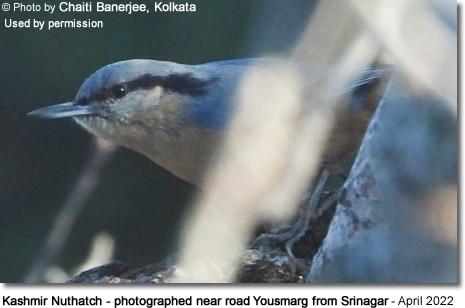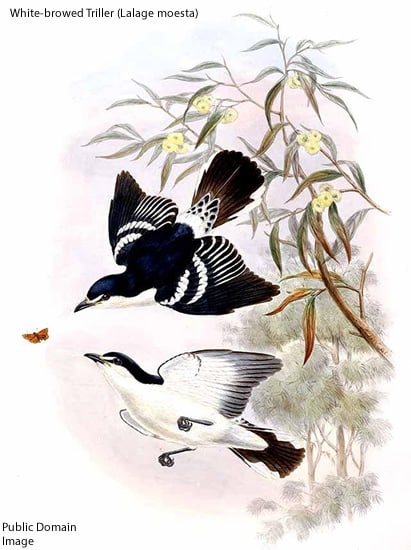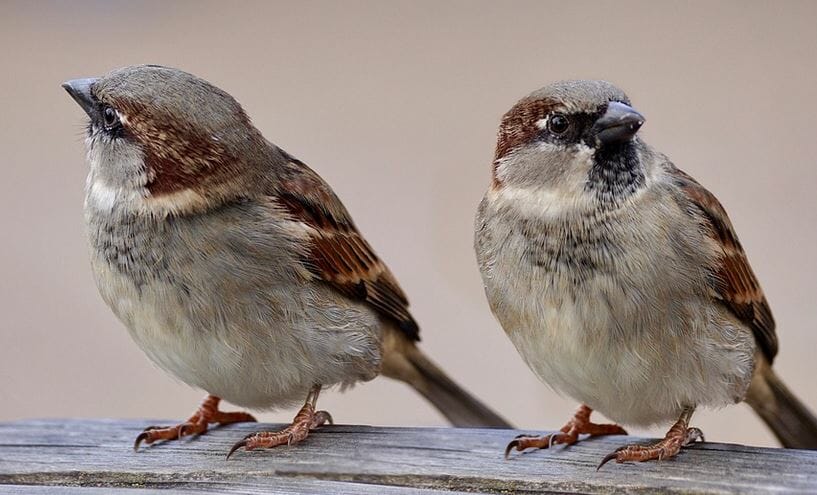Hummingbirds found in Oregon, USA
Hummingbirds found in the USA (by U.S. State) … Canada … Mexico … Puerto Rico … Jamaica … Honduras
Hummingbird Information … Hummingbird Species Photo Gallery
The following hummingbird species have been reported in Oregon.
Migratory hummingbirds usually arrive in late February or March and may remain until early September. The best time to observe hummingbirds in Oregon is the summer (August) – during the post-breeding dispersal period. The juvenile and adult hummingbirds are fattening up for the long and exhausting migration south to their winter territories. All, but the Anna’s hummingbirds, will migrate south (or east) to their wintering territories.
Anna’s Hummingbirds, Calypte anna – Native Breeders and Year-round Residents – This is only known resident hummingbird throughout the year. They nest regularly in Oregon (Willamette Valley and Coast). The Anna’s Hummingbird is much less common in Central Oregon than the Rufous Hummingbird.
They are usually found in suburban parks, gardens and valleys. Some Anna’s Hummingbirds are resident where food (flowers and feeders) and shelter is readily available. Anna’s may move seasonally to make best use of local resources, such as flowering seasons or availability of feeders – these movements are usually more to elevation than to latitude.
The largest hummingbird species in that region and one of the most vocal hummingbirds in the United States, where it is the only species to produce a song; specifically the males produce a complex series of scratchy noises, sounding like a sharp “chee-chee-chee; when moving from flower to flower, they emit toneless “chip” vocalizations. All other hummingbirds in the United States are mostly silent.
They are well known for their territorial behavior; the male makes elaborate dive displays at other birds and sometimes even at people. At the bottom of their dives, they produce high-pitched loud popping sounds with their tail feathers.
Males have glossy dark rose-red throats and crowns, which may appear black or dark purple in low light. The underside is mostly greyish; and the back metallic green.
Females have light grey chests with white and red spotting on the throat, greenish back and white tipped tails.
They resemble the Costa’s Hummingbirds, but the male’s Costa’s Hummingbird‘s gorget (throat feathers) is longer than that of the Anna’s. They are larger than the Rufous Hummingbirds and lack the rusty coloration of the Rufous Hummingbirds. Male Anna’s have brilliant red feathers on the top of the head as well as the throat.
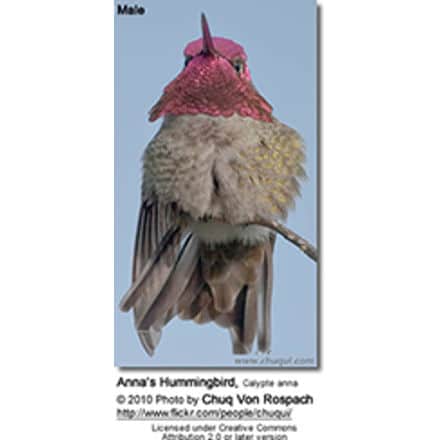
Rufous Hummingbirds, Selasphorus rufus – Seasonal – Arrive in their breeding territory in California and Oregon around April. They mostly nest in the mountains, but are widespread west of the Cascades. Occur from late February to September. They migrate south to Mexico and Central America for the winter.
These hummingbirds are usually found in gardens and at feeders. These birds are fearless, and are known for chasing away other hummingbirds and even larger birds, or rodents away from their favorite nectar feeders and flowers.
Males can easily be identified by their glossy orange-red throats.
Females have whitish, speckled throats, green backs and crowns, and rufous, white-tipped tail feathers.
Allen’s Hummingbirds, Selasphorus sasin – Rare vagrants – The Allen’s Hummingbird is often confused with the Rufous Hummingbird, but the Allen’s can be identified by the green back whereas the Rufous Hummingbird has a coppery back.
The male has a throat that ranges in color from orange-red to yellow-orange, a back that is bright green, a rump that is rufous and its tail feathers are rufous tipped in black.
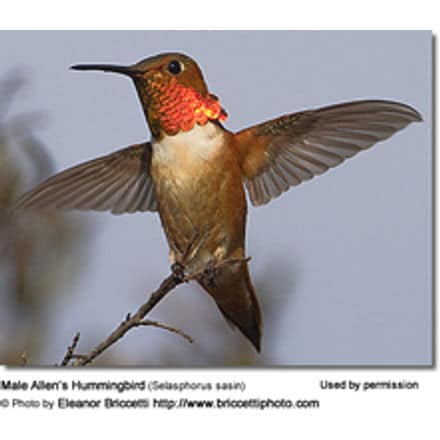
Black-chinned Hummingbirds, Archilochus alexandri – Small hummingbirds that mostly nest in Northeast Oregon. Migratory hummingbirds – occur from late February to September.
The male has a black, shimmering throat with a purple edge and pale feathers below that create a collar. However, unless the light is just right, the head looks all black. His back is green and there are some green feathers covering the chest.
The female is pale below (sometimes with a slightly speckled throat) and her back is green.
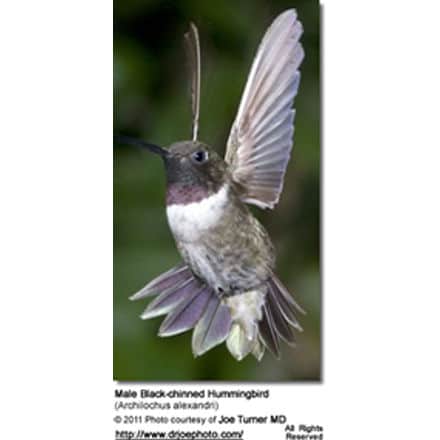
Broad-billed Hummingbirds (Cynanthus latirostris) – Occasional visitors – No records of this mostly Mexican species breeding in Oregon, but these birds are seen more frequently and may nest in this state in the future.
The male is glossy green above and on the chest. He has a deep blue throat. His straight and slender beak is red with a black tip. His slightly forked tail is dark above, and the under tail feathers are white.
The female is less colorful than the male. Her throat, chest and belly are light to medium grey. She has a white stripe over each eye.

Broad-tailed Hummingbird, Selasphorus platycercus – Native – Regularly nest in the mountains of extreme Northeast and Southeast Oregon. These migratory hummingbirds breed across mountain forests and meadows throughout the Western United States from eastern California and northern Wyoming south through Great Basin and Rocky Mountain states to southern Arizona and western Texas. They move south to winter in Mexico, Guatemala and, occasionally, El Salvador.
Males can most easily be identified by their iridescent, rose-red throats, white chest feathers and metallic green back and crown and their rounded tails. The males’ tails make whistling noises in flight.
Females lack the flashy throat patch of the male and are mostly pale below. Their white-tipped outer tail feathers are rust-colored close to the body and blackish in the center; the tail feathers in the center range from green to blackish.
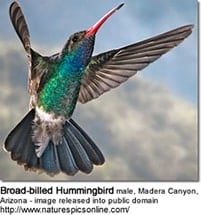
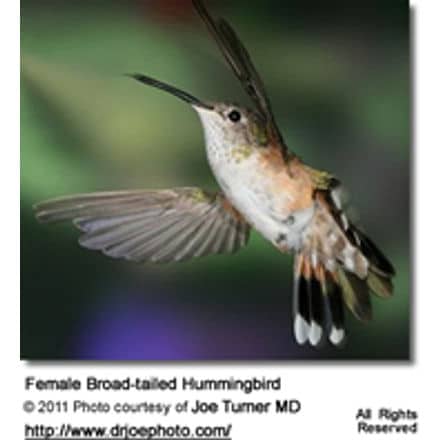
Calliope Hummingbird, Stellula calliope –Seasonal Migrant – Mostly nests in the Cascade and Wallowa Mountains. They migrate south or east for the winter. Occur from late February to September.
The smallest breeding bird in North America. They are most easily confused with the Rufous Hummingbirds and the Broad-tailed Hummingbird.
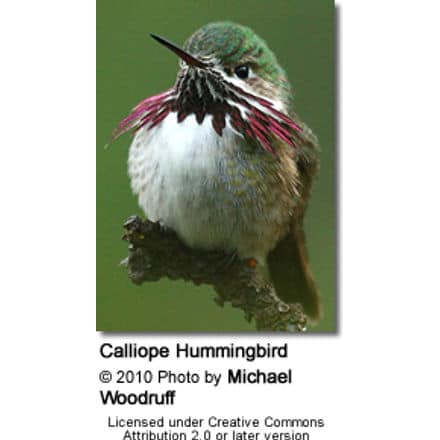
Costa’s Hummingbirds, Calypte costae – Not currently known (2011) to nest in Oregon, but they are being seen more frequently and may nest in this state in the future.
Males can easily be identified by the glossy purple crown and long, conspicuous throat feathers that project markedly down the side of the throats, giving it an elongated “moustache” appearance. The back is metallic green.
Females have greyish-green crowns (fop of the head) and backs. The chin and the plumage below are whitish, except for some black spotting on her throat. Her flanks are buffy-colored. She has a dark tail with white tips on the outer tail feathers.
They resemble the Anna’s Hummingbirds, but the male’s gorget (throat feathers) is longer than that of the Anna’s.

Xantus’s Hummingbirds (Basilinna xantusii) – Rare vagrants. This Mexican hummingbird has been venturing into California on a regular basis. Some travel up the Pacific coast of North America to British Columbia in Canada.
ID: Identified by distinctive white eyestripes with a black line below. The head and back is mostly green. Below they are cinnamon brown. The male has a green throat (brownish in the female). Male has a red, black-tipped beak; female beak is brownish. Dark, straight tail.
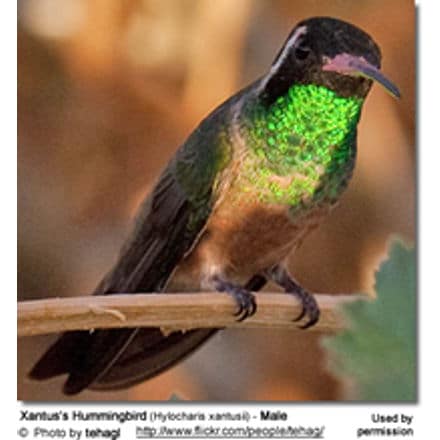
The favorite feeding plants for Oregon Hummingbirds are:
Many hummingbirds favor red blossoms with a tubular shape (but some species prefer other colors). Hummingbirds feed readily on pink, blue, orange, peach and purple flowers.
- Western Columbine: Small shrub with yellow and red flowers during the spring
- Red Larkspur: Shrub with bold red flowers that flourish from May through June.
- Coral Honeysuckle: A vine that can climb up 20 feet with red tubular flowers
- Hanging baskets with Hummingbird-feeding plants:
- Begonia: Available in a wide range of colors, including pink, red, yellow, orange or white.
- Salvia Celestial Blue or Purple Sage: Produces purplish-blue flowers. Tolerates extreme heat.
- California Indian Pink: Likes shady locations. Produces bright red flowers that bloom in the spring.

